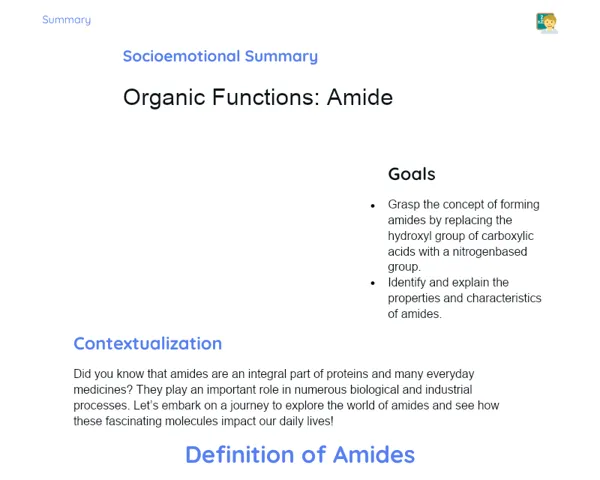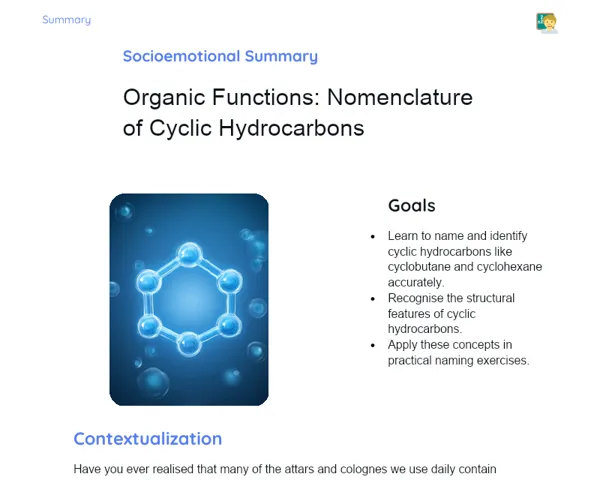Socioemotional Summary Conclusion
Goals
1. Recognize and understand the IUPAC nomenclature of acyl halides.
2. Differentiate the nomenclature of acyl halides from that of other organic compounds.
Contextualization
Did you know that acyl halides are extremely significant in the chemical and pharmaceutical sectors? 🌟 They're crucial in developing medicines and several everyday products! Mastering their nomenclature is vital not just for those aspiring to work in chemistry but also for ensuring safety when dealing with these substances. Let's delve into this intriguing world laden with opportunities together! 🧪✨
Exercising Your Knowledge
Structure of Acyl Halides
Acyl halides are organic compounds that originate from carboxylic acids, where the hydroxyl group (-OH) is substituted by a halogen (F, Cl, Br, or I). This change significantly enhances the reactivity of the compound, rendering them more adaptable in chemical synthesis. Understanding this structure is crucial for accurate naming and practical applications of acyl halides.
-
General Formula: The general formula for acyl halides is R-CO-X, where R represents an alkyl or aryl group, CO is the carbonyl group, and X is a halogen. Grasping this formula is essential for correctly identifying and naming these compounds.
-
Substitution of the Hydroxyl Group: Swapping the hydroxyl group (-OH) with a halogen boosts the compound’s reactivity, enabling a range of vital chemical reactions in organic synthesis.
-
Practical Application: Being able to identify and comprehend the structure of acyl halides allows for their use in numerous chemical reactions, which aids in producing pharmaceuticals and other essential chemicals.
IUPAC Nomenclature of Acyl Halides
IUPAC nomenclature (International Union of Pure and Applied Chemistry) represents the standard system for naming chemical compounds. For acyl halides, the nomenclature entails replacing the '-ic' ending of the corresponding carboxylic acid name with '-yl' and appending the halogen name. This structure allows chemists globally to communicate clearly and unambiguously.
-
Naming Rules: Understanding the naming rules for acyl halides follows a specific pattern that, once comprehended, simplifies the correct naming of any acyl halide.
-
Practical Examples: For instance, the acyl halide derived from acetic acid (ethanoic acid) is termed acetyl chloride (ethanoyl chloride). Other instances include benzoyl bromide (C6H5COBr) and formyl chloride (HCOCl).
-
Importance of Nomenclature: Proper use of IUPAC nomenclature is crucial to avoid misunderstandings and ensure clear communication in scientific and professional contexts.
Importance of Acyl Halides in Industry
Acyl halides are vital in the chemical and pharmaceutical industries. They serve as key intermediates in synthesizing various compounds, including esters and amides, essential in manufacturing medicines and other chemicals. Moreover, accurate identification and handling of these compounds are paramount for ensuring safety and efficacy in industrial processes.
-
Synthesis of Esters and Amides: Acyl halides are pivotal in producing esters and amides, which are critical components in numerous medications and chemical products.
-
Chemical Safety: Knowing and correctly naming acyl halides is vital for safety when handling and producing chemical substances, preventing accidents and ensuring the quality of the final product.
-
Professional Relevance: For those aiming to carve out a career in chemistry, especially within the industrial and pharmaceutical domains, mastering the nomenclature and application of acyl halides is an indispensable skill.
Key Terms
-
Acyl Halides: Organic compounds where the hydroxyl group of a carboxylic acid is replaced by a halogen.
-
General Formula: The fundamental structure of acyl halides, represented as R-CO-X.
-
Carbonyl Group: A functional group present in numerous organic compounds, including acyl halides, known for a carbon atom double-bonded to an oxygen atom.
-
IUPAC Nomenclature: The standard naming system for chemical compounds that promotes global scientific communication.
-
Chemical Intermediate: A transitional substance in the synthesis of more complex compounds.
For Reflection
-
How do you manage frustration when encountering challenges in naming compounds? What strategies can you employ to navigate through these moments?
-
Recall a time when teamwork with a colleague was vital in addressing an issue. How did your feelings influence that collaboration?
-
How can your grasp of the structure and nomenclature of acyl halides be applied beyond chemistry? Think about elements like organization and precision in other areas of your life.
Important Conclusions
-
Acyl halides are significant organic compounds, formed from carboxylic acids, characterized by a structure where the hydroxyl group is substituted by a halogen.
-
The IUPAC nomenclature of acyl halides is fundamental for clear and precise communication within the chemistry domain.
-
Mastering the nomenclature and structure of acyl halides is key to practical applications in the chemical and pharmaceutical industries, ensuring safety and efficiency in their processes.
Impacts on Society
Acyl halides greatly influence our society, particularly in the pharmaceutical sector. They play a crucial role as intermediates in producing medications that can save lives and enhance public health. Understanding the naming and handling of these compounds ensures scientists can safely and effectively develop new therapies and treatments. 🌍💊 Furthermore, precision in nomenclature and the handling of acyl halides is essential in research labs and chemical manufacturing facilities, helping to avert accidents and maintain product quality. These compounds contribute to materials we use daily, such as plastics and adhesives, stressing the importance of a solid grasp of organic chemistry for technological advancement and industrial safety. 🧪🔬
Dealing with Emotions
Take a moment to reflect on the emotions you experienced during today's lesson. 🧘♂️🧘♀️ For the next 5 minutes, try to identify and articulate these emotions (for example, 'frustration', 'satisfaction', 'doubt'). Then, ponder on what triggered these feelings and how they impacted your learning. Write a brief paragraph on how you can express these emotions positively and manage these feelings better in future academic situations. 🤔✍️ Recognizing and understanding your emotions is the first step toward effectively managing them. Try techniques like deep breathing or meditation to calm yourself before facing academic challenges. You'll notice improved concentration and efficiency! 🚀
Study Tips
-
Regularly review the nomenclature of acyl halides. Create flashcards with different examples and practice naming them until you gain confidence. 📚
-
Join a study group with your classmates. Discussing and explaining the information to others can strengthen your understanding and enhance your social skills. 👥🔬
-
Utilize online resources like educational videos and virtual simulations to visualize practical applications of acyl halides, reinforcing your learning. 🌐🎥



